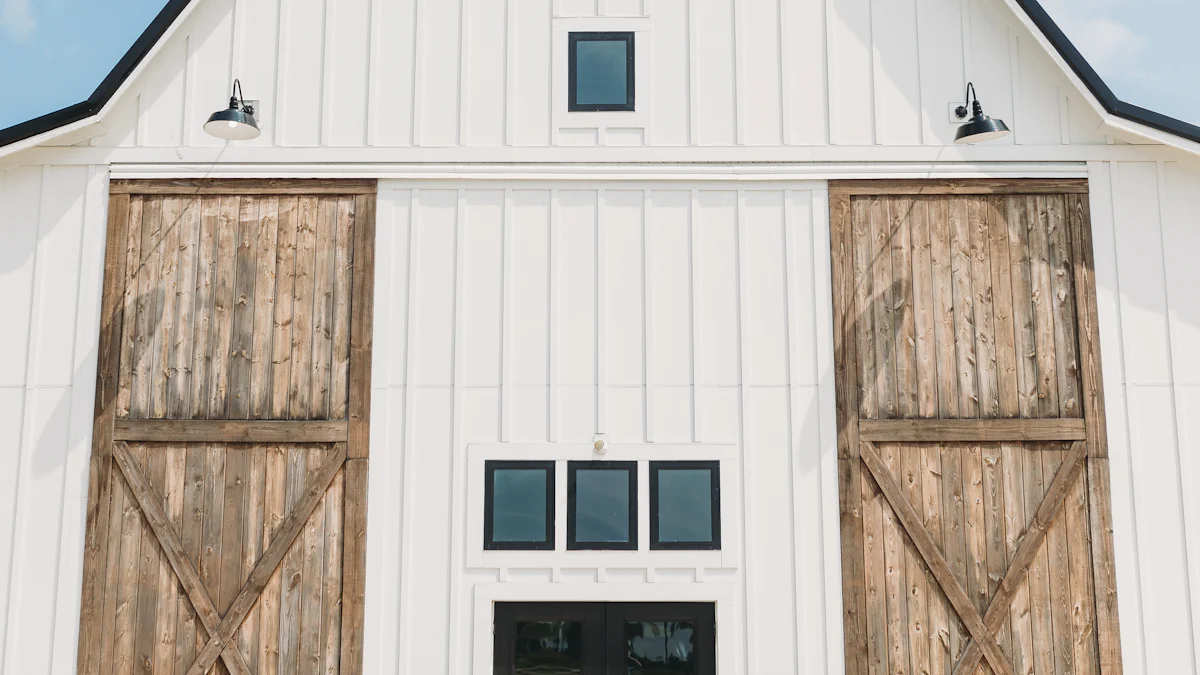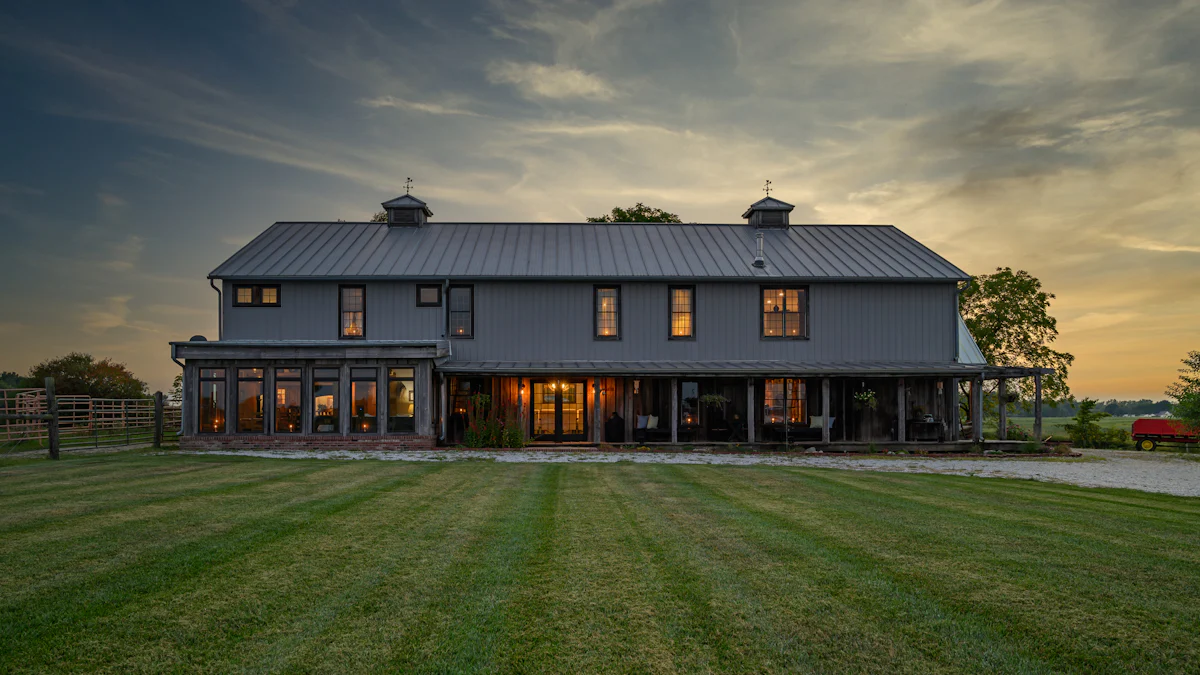How to Finance Your Barndominium Build in 2025

Building a barndominium in 2025 is more achievable than ever. Lenders now recognize these unique homes as viable properties, making financing options more accessible. Plus, barndominiums cost less to construct than traditional homes, which is a big win if you're navigating high housing prices. Whether you're considering obtaining a construction loan to build a barndominium or exploring alternative financing, there's a solution for you. With the right plan, you can turn your dream of owning a barndominium into reality.
Key Takeaways
-
Plan your budget by asking contractors for price estimates. Include all costs like utilities and permits to avoid surprises.
-
Check your credit score and collect financial papers. A score of 620 or higher improves your chances of getting a loan.
-
Look into different loan types, like FHA, USDA, or VA loans. Pick the one that fits your needs and budget best.
-
Get preapproved for a loan to make financing easier. This shows lenders you are serious and helps you understand loan details.
-
Save 10-15% of your budget for unexpected costs. This extra money helps keep your project running smoothly.
Determine Your Budget
Assess the Total Cost
Before you dive into building your barndominium, you need to figure out how much it will cost. Start by getting quotes from contractors and suppliers. This will give you a clear idea of what you’re working with. The average cost of constructing a barndominium in 2025 ranges from $112,800 to $540,000, with most people spending around $265,000. This includes everything—land, permits, and materials.
Don’t forget to account for utilities and permits, especially if your barndominium will be in a rural area. Here’s a quick breakdown of typical costs:
-
Road Work: $70 to $170 per foot
-
Electricity: $25 to $50 per foot
-
Septic System: $5,000 to $8,000
-
100-Foot Well: $6,000 to $10,000
-
Water Treatment: $1,000 to $3,000
-
Building Permits: $500 to $2,000
These numbers can add up quickly, so make sure you include them in your budget. If you’re hiring an architect or structural engineer, their fees can range from $15,000 to $80,000 for full design services or $100 to $220 per hour.
Plan for Contingencies
Even the best-laid plans can hit a snag. That’s why you should set aside a contingency fund for unexpected expenses. Did you know that 90% of construction projects experience cost overruns? On average, these overruns add about 28% to the total cost. By planning ahead, you can avoid financial stress if something goes off track.
Material prices can also fluctuate. For example, lumber and steel costs might spike unexpectedly. A contingency fund helps you handle these changes without derailing your barndominium project. Experts recommend adding at least 10-15% of your total budget as a cushion. This proactive step ensures you’re prepared for surprises and keeps your dream build on schedule.
Prepare Financially
Check Your Credit Score
Your credit score plays a big role in obtaining a construction loan to build a barndominium. Most lenders prefer a score of 620 or higher, but some may be more flexible. Here’s a quick look at the minimum credit score requirements for different loan types:
|
Loan Type |
Minimum Credit Score |
|---|---|
|
Conventional |
620 |
|
FHA |
580 |
|
USDA |
If your score needs improvement, don’t worry. You can take steps to boost it. Start by paying your bills on time. Late payments can hurt your score, so staying consistent is key. Reduce your debt by keeping balances low on credit cards and other accounts. Check your credit report for errors and fix any issues you find. Finally, avoid applying for new credit unless it’s absolutely necessary. These strategies can help you qualify for an FHA construction loan or other financing options.
Gather Financial Documents
Lenders will ask for several documents when you apply for a construction loan. Be prepared to provide:
-
Tax returns
-
Bank statements
-
Proof of income
-
Employment details
You’ll also need to share detailed plans for your barndominium. This includes a construction plan, budget, and information about your licensed contractor or builder. Having these documents ready shows lenders you’re serious and organized, which can speed up the approval process.
Save for a Down Payment
Most barndominium loans require a down payment of 10% to 20%. However, FHA construction loans can reduce this to just 3.5% if your credit score is 580 or higher. This makes FHA loans a great option if you’re looking to save money upfront. Research the down payment requirements for your chosen loan type and start saving early. If you’re working with a licensed contractor or builder, they may also offer financing options that could help with your initial costs.
By preparing financially, you’ll set yourself up for success when obtaining a construction loan to build a barndominium. Taking these steps now will make the process smoother and get you closer to your dream home.
Explore Loan Options

Conventional Loans
You might think a conventional construction loan is the easiest way to finance your barndominium. While it’s possible, there are some challenges to keep in mind. Lenders often require appraisals to ensure the property can be sold on the open market. For barndominiums, this can be tricky because they’re so unique. Appraisers may struggle to find comparable properties, which could complicate the process.
To qualify, you’ll need to meet certain lender requirements. These typically include:
-
A good credit history with a minimum credit score.
-
Proof of stable income or employment.
-
A debt-to-income ratio that meets the lender’s standards.
-
Residency and legal status in the U.S.
If you’re confident you can meet these criteria, a conventional loan might work for you. Just be prepared for the extra steps involved with unconventional builds like barndominiums.
FHA Construction Loan
An FHA construction loan is a popular choice for barndominium projects. Why? It offers several benefits that make financing easier:
|
Benefit |
Description |
|---|---|
|
Lower Down Payment |
FHA loans require a down payment as low as 3.5%, making homeownership more accessible. |
|
Flexible Credit Requirements |
FHA loans have more lenient credit requirements, making them suitable for those with lower scores. |
|
Fixed Interest Rates |
A 30-year fixed-rate FHA loan offers stability with consistent monthly payments for budgeting. |
To qualify, you’ll need to meet specific eligibility criteria:
-
A FICO score of at least 580 for a 3.5% down payment or 500 for a 10% down payment.
-
A debt-to-income ratio ideally under 50%.
-
A detailed construction plan and proof of employment.
-
The property must be your primary residence.
If you meet these requirements, an FHA construction loan could be the perfect fit for your barndominium project.
Construction-to-Permanent Loan
A construction-to-permanent loan simplifies the financing process for your barndominium. Here’s how it works:
-
You start with a construction loan to fund the building process.
-
Once construction is complete, the loan converts into a permanent mortgage.
This eliminates the need for multiple loans, saving you time and effort. The process typically involves these steps:
-
Choose a builder and provide their plans and estimates to your lender.
-
Close the loan before construction begins.
-
Pay interest only during construction, with funds released in stages.
-
Complete construction and schedule a final inspection.
-
Apply for a permanent mortgage and finalize the conversion.
This option is great if you want a seamless transition from building to owning your barndominium.
Other Government-Backed Loans
USDA loans for rural barndominium properties
If you're planning to build your barndominium in a rural area, a USDA loan might be a perfect fit. These loans are government-backed and designed to help low-to-moderate-income borrowers achieve homeownership without needing a down payment. To qualify, your barndominium must be in a designated rural area and meet specific guidelines. For example, it needs to be structurally sound and have functional systems like heating, cooling, and electricity.
You’ll also need to meet income requirements. For a household of 1-4 members, the income limit is $112,450, while for 5-8 members, it’s $148,450. Keep in mind that your monthly housing expenses shouldn’t exceed 34% of your income, and your total debt-to-income ratio must stay under 41%. If you meet these criteria, a USDA loan can make your barndominium dream more affordable.
VA loans for veterans and active-duty military
If you’re a veteran or active-duty service member, a VA loan could be your best option. These loans don’t require a down payment, which is a huge advantage. They also have lenient credit requirements, making them accessible even if your credit score isn’t perfect. However, your barndominium must meet specific VA guidelines, such as being your primary residence and meeting safety standards. With no down payment and competitive interest rates, VA loans are an excellent choice for those who qualify.
Alternative Financing Options
Personal loans or home equity loans for barndominiums
Personal loans and home equity loans offer flexibility, but they come with pros and cons. A personal loan doesn’t require collateral, so your property isn’t at risk if you default. However, these loans often have higher interest rates and lower borrowing limits, which might not cover the full cost of your barndominium.
On the other hand, a home equity loan lets you borrow against the equity in your current home. This option usually comes with a fixed APR, making it easier to budget. But you’ll need enough equity in your home to qualify, which isn’t always possible for everyone. Both options can work, depending on your financial situation and the cost of your barndominium.
Financing options offered by barndominium builders
Many barndominium builders offer financing options tailored to these unique homes. These can include construction loans, USDA loans, and even VA loans. Construction loans are particularly useful because they provide phased funding as your barndominium is built. Once construction is complete, these loans can convert into permanent mortgages.
Builders often work closely with lenders who understand the challenges of financing a barndominium, such as appraisal difficulties. This partnership can make the process smoother for you. If you’re working with a builder, ask about their financing options to see if they align with your needs.
Compare and Apply for Loans
Get Preapproved
Getting preapproved for barndominium financing is a smart first step. It simplifies the loan process and shows lenders that you’re financially ready. Preapproval also gives you a clear picture of what loan terms you qualify for, helping you set realistic expectations. Here’s why it’s worth it:
-
You can compare offers from different lenders with confidence.
-
It demonstrates your financial readiness, which lenders appreciate.
To get preapproved, you’ll need to gather some documents. These typically include:
-
Tax returns and W-2 statements from the past two years.
-
Recent pay stubs and bank statements.
-
Details about your barndominium’s construction, such as plans and builder contracts.
Having these documents ready speeds up the process and makes you look prepared.
Compare Loan Offers
Once you’re preapproved, it’s time to compare loan offers. Don’t just focus on interest rates—look at the bigger picture. Evaluate the terms, fees, and repayment options. Some lenders might offer lower rates but charge higher fees, so read the fine print carefully.
Also, consider the lender’s reputation and customer service. Not all lenders understand the unique challenges of financing a barndominium. Those with experience in rural property loans or non-traditional homes are often better equipped to handle your needs. A lender with excellent customer service can make the process smoother and help resolve any issues quickly.
Submit Your Loan Application
When you’ve chosen the best loan program, it’s time to submit your application. Follow these steps to ensure everything goes smoothly:
-
Gather all necessary documents, including financial records, construction plans, and builder contracts.
-
Submit your application to the lender and answer any questions they have about your project.
-
The lender will begin the underwriting process, where they review your financial information and verify your documentation.
-
An appraisal may be ordered to confirm the value of your barndominium.
-
If everything checks out, the lender will approve your loan, and you’ll move on to closing.
During underwriting, stay in touch with your lender and provide any additional information they request. This helps avoid delays and keeps your barndominium project on track.
Finalize Financing and Start Construction

Close on Your Loan
Closing on your loan is the final step before construction begins. At this stage, you’ll review and sign the final loan documents. Take your time to understand the terms and conditions. Here are some key points to check:
-
Credit Score and History: Ensure your credit score aligns with the lender’s requirements.
-
Income and Employment: Confirm that your proof of stable income is accurate and up-to-date.
-
Debt-to-Income Ratio: Verify that your DTI ratio meets the lender’s standards.
Loan terms can vary significantly. Construction loans often have higher interest rates than traditional mortgages, and their terms typically range from 12 to 18 months. Once your barndominium is complete, you’ll switch to a permanent loan, which can extend up to 30 years.
Before signing, follow these steps to avoid surprises:
-
Review all documents carefully.
-
Gather any additional paperwork, like proof of income or title insurance.
-
Schedule your closing date with all relevant parties.
-
Double-check the closing disclosure for errors.
-
Sign the documents to finalize the process.
Once you close on the construction loan, you’ll gain access to the funds needed to start building. These funds, known as draws, will be disbursed in stages as construction progresses.
Begin Construction
With financing secured, it’s time to bring your barndominium to life. Start by working closely with your contractor to ensure everything is on track. Regular communication is key. Schedule frequent check-ins to discuss progress and address any concerns.
To keep your project on budget, establish a tracking system. Monitor every expense and compare it against your original plan. Avoid last-minute changes, as they can lead to unexpected costs. Regular site visits can also help you stay informed about the construction’s progress.
Here are some best practices to manage your budget and timeline effectively:
-
Track all expenses meticulously to prevent overruns.
-
Conduct regular reviews to ensure spending aligns with your budget.
-
Communicate openly with your contractor to avoid misunderstandings.
By staying proactive, you’ll ensure your barndominium is completed on time and within budget. Once construction wraps up, you’ll transition seamlessly to your permanent loan, marking the final step in your journey to owning your dream home.
Financing your barndominium build in 2025 doesn’t have to feel overwhelming. By breaking it down into steps—like setting your budget, preparing your finances, and exploring loan options—you can make the process manageable. Once you finalize your financing, you’ll be ready to start construction and watch your dream home take shape.
If you’re ready to finance a barndominium, now’s the time to start planning. Take the first step today, and you’ll be one step closer to living in your custom-built barndominium.
FAQ
What is the best loan option for barndominium construction?
The best loan depends on your situation. FHA 203(k) loans are great for low down payments, while construction-to-permanent loans simplify financing. If you’re in a rural area, USDA loans might work. Compare options to find what fits your needs.
Can I use an FHA 203(k) loan for barndominium construction?
Yes, you can! The FHA 203(k) loan is ideal for barndominium construction or rehabilitation. It covers building costs and allows you to combine construction and mortgage financing into one loan. This makes it a convenient choice.
What’s the difference between an FHA 203(k) loan and an FHA 203(k) rehabilitation loan?
Both loans are similar, but the FHA 203(k) rehabilitation loan focuses on renovating existing structures. If you’re building a barndominium from scratch, the standard FHA 203(k) loan is more suitable. Always check with your lender for eligibility.
How much should I budget for unexpected costs during barndominium construction?
Set aside 10-15% of your total budget for surprises. Construction projects often face price fluctuations or unforeseen issues. A contingency fund ensures you’re financially prepared for anything that comes up during the build.
Can I finance my barndominium through a builder?
Yes, many builders offer financing options tailored to barndominium construction. These may include phased construction loans or partnerships with lenders who understand unique builds. Ask your builder about their financing programs to see if they fit your needs.
Back
